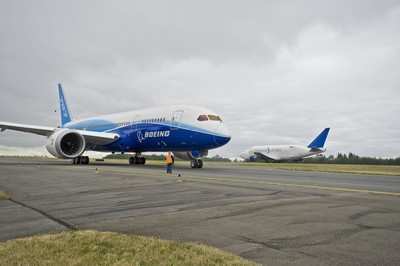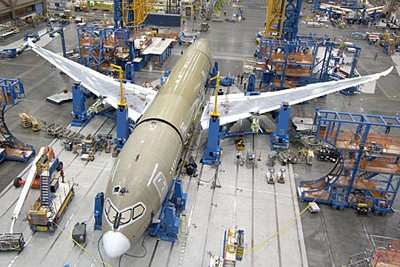Fri, Aug 28, 2009
Test Airplane And Static Test Units Are Prepped For Wing And
Fuselage Modifications
We've been hearing this for a week or so, but Boeing has finally
made it official. The company announced late Thursday that the
first flight of the 787 Dreamliner is expected by the end of 2009
and first delivery is expected to occur in the fourth quarter of
2010.

The new schedule reflects the previously announced need to
reinforce an area within the side-of-body section of the aircraft,
along with the addition of several weeks of schedule margin to
reduce flight test and certification risk. The company projects
achieving a production rate of 10 airplanes per month in late
2013.
"This new schedule provides us the time needed to complete the
remaining work necessary to put the 787's game-changing capability
in the hands of our customers," said Boeing Chairman, President and
Chief Executive Officer Jim McNerney. "The design details and
implementation plan are nearly complete, and the team is preparing
airplanes for modification and testing."

Based on the revised schedule and other assumption updates, the
company has determined that the 787 program is not in a
forward-loss position.
However, separate from the updated program profitability
assessment, the company has concluded that the initial flight-test
airplanes have no commercial market value beyond the development
effort due to the inordinate amount of rework and unique and
extensive modifications made to those aircraft. Therefore, costs
previously recorded for the first three flight-test airplanes will
be reclassified from program inventory to research and development
expense, resulting in an estimated non-cash charge of $2.5 billion
pre-tax, or $2.21 per share, against third-quarter results. This
charge will have no impact on the company's cash outlook going
forward.
The 787 team working the side-of-body reinforcement has
completed initial testing and is finalizing design details of new
fittings that are expected to ensure full structural integrity of
the joint. The static test procedure that uncovered the issue will
be repeated and the results fully analyzed before first flight is
conducted. Fatigue testing also will be performed on stringer
components to validate the long-term durability of the
modification.

The first 787 test airplane and static test unit have been
prepared for the new fittings. Installation is expected to begin
within the next few weeks.
More News
NASA Takes in Orion, Begins Launch Processing for a Crewed Mission Aerospace giant Lockheed Martin recently turned in its share of the Artemis II venture, delivering its Orion spac>[...]
During The Forced Landing, The Airplane Landed Short Of The Runway And Left Of The Runway Centerline Analysis: The pilot reported that, during the initial climb, the engine lost pa>[...]
From 2010 (YouTube Edition): Company Pioneers Alternatives For Bell 206 TR Blades The approved part replacement business can be a tough one... especially when you're competing with>[...]
Obstacle An existing object, object of natural growth, or terrain at a fixed geographical location or which may be expected at a fixed location within a prescribed area with refere>[...]
“NATA’s 3,700 member companies operate at nearly 4,500 airports in thousands of communities across the nation, providing air transportation services, driving economic g>[...]
 Lockheed Hands Over Completed Artemis II Spacecraft
Lockheed Hands Over Completed Artemis II Spacecraft NTSB Final Report: Pulsar Super Pulsar
NTSB Final Report: Pulsar Super Pulsar Classic Aero-TV: Van Horn Rotor Blades -- Tail Rotor Replacements For Bell's 206
Classic Aero-TV: Van Horn Rotor Blades -- Tail Rotor Replacements For Bell's 206 ANN's Daily Aero-Term (05.02.25): Obstacle
ANN's Daily Aero-Term (05.02.25): Obstacle Aero-News: Quote of the Day (05.02.25)
Aero-News: Quote of the Day (05.02.25)





